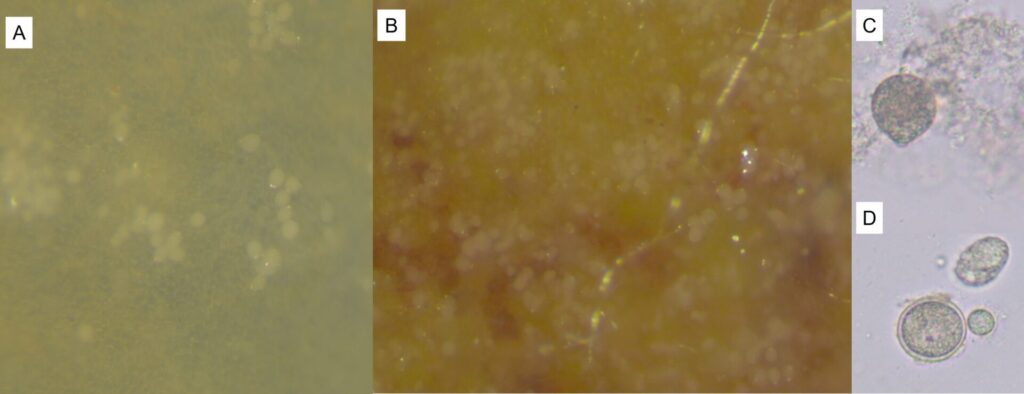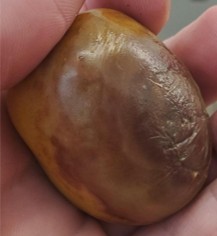Over the last few weeks, we have received multiple tomato samples at the Purdue Plant and Pest Diagnostic Lab with buckeye rot of the fruit. This is likely due to the recent wet and humid weather we have been experiencing. Buckeye rot is a disease caused by three different Phytophthora species: P. capsici, P. drechsleri, and P. nicotianae. We often find that P. nicotianae is more common than P. capsici or P. drechsleri in IN. Symptoms often develop as gray-green to green-brown lesions that spread across the fruit (Figure 1). Lesions may appear diffuse or water-soaked around the leading edge, but they will become brown and can develop concentric circles as it spreads (Figure 2). Over time, infected fruit can also be colonized by secondary soft rot organisms, which will eventually cause the fruit to rot and fall apart. Until that time, the fruit tends to stay somewhat firm.
Phytophthora is an oomycete, or a water mold, and is a soilborne organism, so affected fruit tends to be either in contact with the soil itself or lower in the plant canopy where soil can splash up onto the fruit. Disease severity tends to be higher during warm, wet weather, especially in conditions where there is standing water, as the oomycete produces sporangia under humid or flooded conditions that can be spread by water splash (Figure 3).

Figure 3: Caption: Symptomatic tomato tissue was placed in a dish and covered with water. Within 48 hours, Phytophthora sporangia began to grow profusely from the infected, symptomatic tissue. A) green tissue on the infected fruit, B) brown tissue on the infected fruit, both with significant amounts of sporangia. C) A sporangium floating in the water. It has a distinct pear-to-lemon shape. D) Oospores, the overwintering structure produced by Phytophthora, have a thick double wall and can develop in the infected plant tissue (bottom left structure) (Photo by PPDL).
Phytophthora may also infect the roots, crown, and stem of tomato plants, so there may be other disease symptoms present aside from rotting fruit; however, these symptoms are not as common as fruit rot on tomatoes. If you know you have a history of Phytophthora root rot in a particular part of the field, I would recommend scouting for affected fruit during wet periods in the summer.
It is important to note that all three Phytophthora species associated with buckeye rot have fairly wide host ranges. If multiple crops are grown in successive years or if you intend to rotate crops to reduce disease severity in a future cropping season, it is important to determine the type of Phytophthora that is present to ensure the next crop is not at risk.
As indicated, crop rotation can reduce the total amount of inoculum in the soil from one year to the next, but Phytophthora can produce overwintering structures (oospores) that can survive for multiple years in the soil and/or dead plant tissue. It is important to use multiple management strategies to try and reduce pathogen inoculum and disease severity.
- Avoid planting in soil that is compacted or that has poor drainage.
- Plant in raised beds and/or stake tomato stems to elevate the tomato fruit away from the soil
- Avoid working with plants while there is dew or water on the foliage and fruit, as this can help spread pathogens from plant to plant
- Work with healthy plants first before working with symptomatic plants – pick and remove infected fruit from the field to reduce inoculum
- Plant resistant or tolerant varieties, if they are available
- Remove or destroy cull piles of fruits/vegetables from previous crops to avoid pathogen carryover from a previous season
- Apply preventative fungicides to protect healthy fruits and slow the spread of the disease – Information can be found in the Midwest Vegetable Guide (https://mwveguide.org/), or you can contact Dr. César Escalante, the Purdue University Extension Vegetable Pathologist, for management recommendations.
If you believe you have buckeye rot or another disease problem, but would like verification, please feel free to submit a sample to the Purdue Plant and Pest Diagnostic Lab. Sample submission fees for Indiana residents are $11, while samples from out-of-state are $22. Please feel free to reach out with any questions you may have: ppdl-samples@purdue.edu and 765-494-7071.

